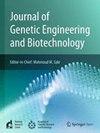In-vitro and bioinformatic studies of bioactive compounds from Oceanimonas sp. JM-AZM31 and Lysinibacillus fusiformis JM-AZM37 of sponge-associated marine bacteria from a mangrove habitat in Southeast Sulawesi
IF 2.8
Q3 Biochemistry, Genetics and Molecular Biology
Journal of Genetic Engineering and Biotechnology
Pub Date : 2025-07-18
DOI:10.1016/j.jgeb.2025.100538
引用次数: 0
Abstract
The ongoing quest for novel therapeutic agents has directed attention toward bioactive compounds derived from sponge-associated bacteria. This study focuses on sponge symbiont bacteria from the mangrove ecosystems in Tanjung Tiram, Southeast Sulawesi, which have not yet been reported for their potential antibacteria, anti-inflammatory, antioxidant, and anti-diabetic activities. The screening of marine bacterial isolates was performed using a series of assays: disc diffusion method to assess antibacterial activity, protein denaturation to assess anti-inflammatory properties, DPPH free radical scavenging to evaluate antioxidant capacity, and α-Glucosidase inhibition for anti-diabetic activity, followed by in silico validation. Two promising strains, identified through molecular techniques were designated as Oceanimonas sp. JM-AZM31 and Lysinibacillus fusiformis JM-AZM37. Initial bioactivity screening revealed significant potential: The bacterial isolates JM-AZM31 and JM-AZM37 demonstrated broad-spectrum antibacterial activity against both Gram-positive pathogens (Bacillus cereus, Staphylococcus aureus, Staphylococcus epidermidis) and Gram-negative pathogens (Escherichia coli, Salmonella typhimurium). JM-AZM31 exhibited an anti-inflammatory inhibition rate of 76.9 ± 2.90 %, antioxidant activity of 80.3 ± 1.02 %, and anti-diabetic activity of 84.9 ± 0.49 %. Similarly, JM-AZM37 showed anti-inflammatory activity of 71.6 ± 1.85 %, antioxidant activity of 76.9 ± 0.03 %, and anti-diabetic activity of 83.2 ± 1.27 %. Further analysis using GC–MS identified five significant compounds, which were examined through in silico molecular docking. Results indicated that n-hexadecanoic acid, DL-proline, 5-oxo-, and cis-vaccenic acid showed high binding affinities to specific therapeutic targets, suggesting strong potential as biotherapeutic agents. This current inquiry concentrates on the therapeutic potential of marine bacteria from mangrove ecosystems as a source of bioactive compounds, positioning Oceanimonas sp. JM-AZM31 and L. fusiformis JM-AZM37 as promising candidates for developing new biotherapeutic treatments.
苏拉威西岛东南部红树林海绵相关海洋细菌中海洋animonas sp. JM-AZM31和fususiformlysinibacillus JM-AZM37活性化合物的体外和生物信息学研究
对新型治疗剂的持续探索将人们的注意力引向了从海绵相关细菌中提取的生物活性化合物。本研究以苏拉威西东南部丹戎提拉姆红树林生态系统中尚未报道的海绵共生细菌为研究对象,研究其抗菌、抗炎、抗氧化和抗糖尿病活性。筛选海洋细菌分离物采用一系列试验:圆盘扩散法评估抗菌活性,蛋白质变性法评估抗炎性能,DPPH自由基清除能力评估抗氧化能力,α-葡萄糖苷酶抑制能力评估抗糖尿病活性,然后进行硅验证。通过分子技术鉴定出两株前景看好的菌株,分别为Oceanimonas sp. JM-AZM31和Lysinibacillus fususiformis JM-AZM37。初步的生物活性筛选显示了显著的潜力:分离的细菌JM-AZM31和JM-AZM37对革兰氏阳性病原体(蜡样芽孢杆菌、金黄色葡萄球菌、表皮葡萄球菌)和革兰氏阴性病原体(大肠杆菌、鼠伤寒沙门菌)均表现出广谱的抗菌活性。JM-AZM31抗炎抑制率为76.9±2.90%,抗氧化活性为80.3±1.02%,抗糖尿病活性为84.9±0.49%。JM-AZM37抗炎活性为71.6±1.85%,抗氧化活性为76.9±0.03%,抗糖尿病活性为83.2±1.27%。进一步的GC-MS分析鉴定了五个重要的化合物,并通过硅分子对接进行了检测。结果表明,正十六酸、dl -脯氨酸、5-氧和顺式异丙酸对特定的治疗靶点具有很高的结合亲和力,表明其作为生物治疗剂具有很强的潜力。目前的研究集中在红树林生态系统中作为生物活性化合物来源的海洋细菌的治疗潜力,将Oceanimonas sp. JM-AZM31和L. fusiformis JM-AZM37定位为开发新的生物治疗方法的有希望的候选物。
本文章由计算机程序翻译,如有差异,请以英文原文为准。
求助全文
约1分钟内获得全文
求助全文
来源期刊

Journal of Genetic Engineering and Biotechnology
Biochemistry, Genetics and Molecular Biology-Biotechnology
CiteScore
5.70
自引率
5.70%
发文量
159
审稿时长
16 weeks
期刊介绍:
Journal of genetic engineering and biotechnology is devoted to rapid publication of full-length research papers that leads to significant contribution in advancing knowledge in genetic engineering and biotechnology and provide novel perspectives in this research area. JGEB includes all major themes related to genetic engineering and recombinant DNA. The area of interest of JGEB includes but not restricted to: •Plant genetics •Animal genetics •Bacterial enzymes •Agricultural Biotechnology, •Biochemistry, •Biophysics, •Bioinformatics, •Environmental Biotechnology, •Industrial Biotechnology, •Microbial biotechnology, •Medical Biotechnology, •Bioenergy, Biosafety, •Biosecurity, •Bioethics, •GMOS, •Genomic, •Proteomic JGEB accepts
 求助内容:
求助内容: 应助结果提醒方式:
应助结果提醒方式:


